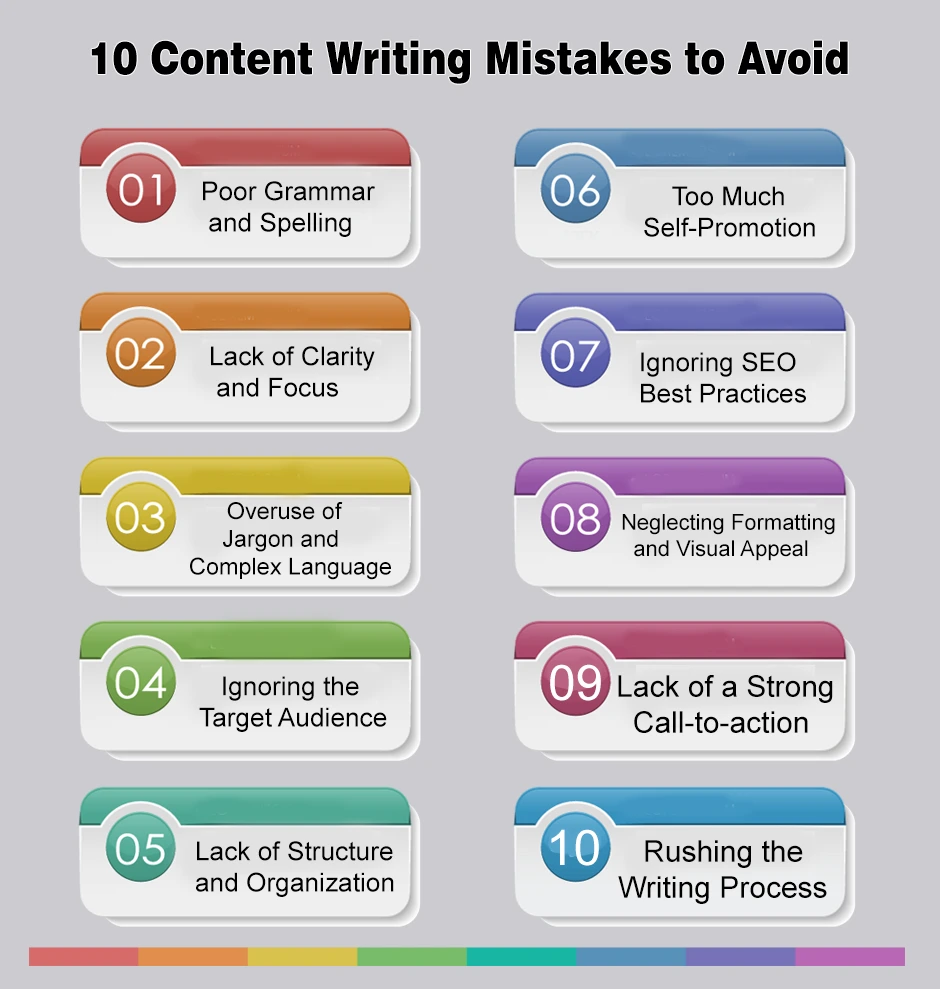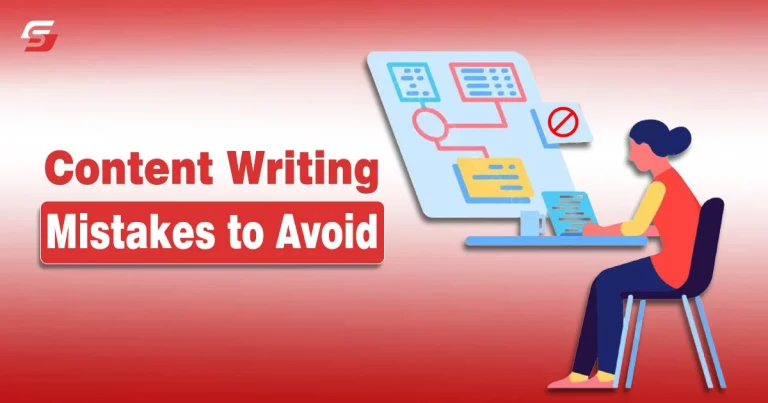Last week, I had a seat with HR for the recruitment tests of the new content writers for our company. In all, I found numerous common mistakes just like blogging mistakes – that were holding up the new writers’ success in their journey. As we all know good style of writing can make any content engaging and useful for the target audience.
As a content writer, I have also learned many techniques about how to make content unique and engaging from all perspectives. Although I made many mistakes, even blunders, in the beginning, over time, I learned to not repeat mistakes.
As a whole, from my new experience with newly hired content writers and my overall journey in this particular field, I have shared some common content writing mistakes to avoid in this guide for better opportunities for writing and hiring.
Further, this brief note is aimed at guiding our readers and the new writers who are interested in starting a writing career at StuffaBlog.
10 Content Writing Mistakes to Avoid
I have mentioned the common content writing mistakes to avoid for a better and easy to rank content creation.

1. Poor Grammar and Spelling
I must say, if you want to write complaining and engaging content, then first improve your grammar mistakes. Poor grammar can damage the relevancy of your content – doubting your expertise and professionalism. However, accurate grammar creates clarity and helps the audience understand your intended message.
Tip: Improve grammar and proofreading of your work. Use tools like Grammarly or seek feedback to ensure clarity and professionalism in your writing.
2. Lack of Clarity and Focus
A lack of clarity and focus in writing can lead to significant issues. When content needs clarity, readers may be able to comprehend the main points and ideas being presented. It can create confusion, leaving the audience engaged and satisfied. Moreover, a lack of focus can result in meandering and irrelevant information, diluting the impact of the message.
Clear and focused writing ensures the intended message is conveyed effectively, keeping the readers attentive and informed. Articles that are well-organized and don’t go off subject are more likely to strike a chord with readers and accomplish their goals.
Tip: Keep your writing concise and structured. Clearly define your main points and organize your ideas logically to maintain the reader’s attention.
3. Overuse of Jargon and Complex Language
Overusing jargon and complex language in writing can confuse readers. You do not rely on technical terminology because it makes difficult for the user to understand the message. Also, these lose interest, which results in less engagement and poor user experience for writers as well as websites.
Tip: It is important to write the content with simple wording that provides a clear message to understand. For example, write simple lines as you are talking with a user, which is engaging content.
4. Ignoring the Target Audience
Ignoring the target audience in writing can be detrimental to the best of the content material. When writers fail to take into account their supposed readers’ possibilities, needs, and understanding degree, the message won’t resonate with them.
Understanding the target audience is important for correctly tailoring the tone, style, and content. As a content writer, you must address your audience’s needs and write quality content which is informative, useful and provides accurate information.
Tip: Research your audience thoroughly and customize your tone, style, and content accordingly to address their specific interests, challenges, and expectations.
5. Lack of Structure and Organization
A lack of structure and organization in writing can make content confusing and ineffective. With a readable framework, ideas may additionally appear cohesive, making it less difficult for readers to follow the flow of data.
The absence of clear headings, subheadings, and well described paragraphs can result in a wall of textual content, overwhelming and discouraging readers from engaging with the material. Organizing content in a logical sequence enhances readability and ensures that the main points are easily identifiable.
Tip: Use clear headings, bullet points, and a logical flow to enhance overall readability. Structured content ensures key points are easily identifiable and keeps readers engaged.
6. Too Much Self-Promotion
Excessive self-promoting in writing can be off-putting to readers and undermine the credibility of the content material. When writers are overly conscious of promoting themselves, their products, or offerings, it may overshadow the real value of the content. It can create a sense of insincerity and push readers away.
Instead of constructing agreement with and engagement, too much self-advertising may also cause disinterest and a loss of authenticity. Effective content material has to prioritize presenting precious information and assembly the target market’s needs.
Tip: It is better to balance advertisement and information to foster a more potent reference to your readers and set up themselves as a credible government. Strike a balance between sharing useful information and subtle promotion to build trust and credibility.
7. Ignoring SEO Best Practices
If you want to rank your content on Google search result pages, it is important to practice SEO-friendly writing. You can add a relevant keywords and place the keyword at the right place.
Beyond this, write a catchy meta description and make headings and sub headings in the content. Seo friendly content not only attracts the readers but also helps to to increase the organic blog traffic.
Tip: Adopt SEO-friendly practices. Search for keyword trends, use relevant keywords naturally, write compelling meta descriptions, and structure your content with clear headings to improve search rankings and user engagement.
8. Neglecting Formatting and Visual Appeal
Content that lacks proper formatting and visual appeal can overwhelm readers, leading to reduced engagement. Blocks of unformatted text and the absence of visuals create a dull reading experience.
Well-structured content with clear headings, bullet points, and visual aids creates a reader-friendly experience. Ignoring the visual aspect may cause readers to overlook valuable information.
Tip: Use formatting elements like bullet points, numbered lists, and subheadings. Incorporate visuals such as images, infographics, and charts to break up the text and maintain reader interest.
9. Lack of a Strong Call-to-action
Content without a clear call-to-action (CTA) can leave readers uncertain about what steps to take next. Whether subscribing to a newsletter, buying, or enticing with social media, a sturdy CTA directs readers towards the desired outcome.
Neglecting to include a powerful CTA can bring about overlooked possibilities for conversions and interactions. A CTA motivates readers to take the desired movement, turning passive observers into lively members.
Tip: Add a compelling and actionable CTA that encourages readers to take the desired step, such as subscribing, sharing, or purchasing.
10. Rushing the Writing Process
Rushing the writing process can lead to subpar content. When writers hurry through their work, they may need to pay attention to grammar, spelling, and logic errors. The lack of thoughtful revision and editing can result in clearer messaging.
Rushing can also hinder creativity and prevent the development of more impactful ideas. Content produced hastily may lack depth and fail to resonate with the audience.
Tip: Dedicate sufficient time to planning, writing, and editing. Thoughtful revisions and refinements always produce high-quality content that effectively communicates your message and leaves a positive impression.
Summary
Content writing requires attention to detail and delivering valuable information to the audience. Avoiding content writing mistakes such as poor grammar, lack of research, and excessive self-promotion is essential to maintain credibility and engage readers effectively.
Content writing is a skill that requires attention to detail, a focus on audience needs, and a commitment to quality. Writers achieve broader audiences and improved user experiences through the implementation of SEO best practices. Successful content writing requires dedicated ongoing enhancement combined with avoidance of common obstacles which produces significant results.











